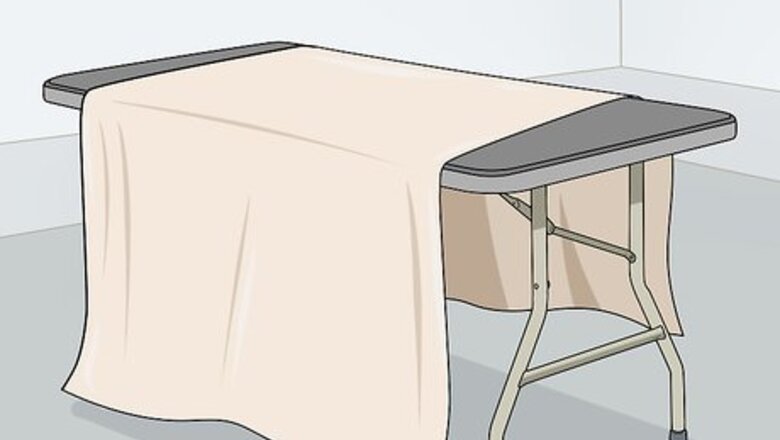
views
Setting up Your Supplies
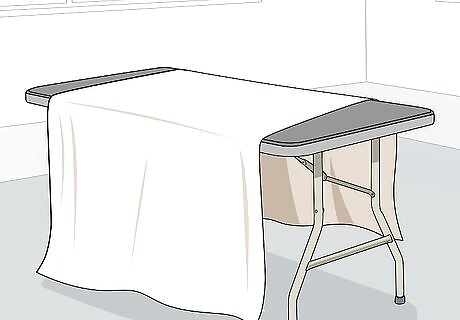
Cover your pouring surface with plastic or cardboard. Pour painting is very messy, so don’t work on a good surface. Lay out a plastic sheet or cardboard to catch any spills while you work. If you’re working inside, spreading a drop cloth on the floor is also a good idea, just in case there are any drips.

Prime the canvas with gesso 24 hours before you paint. Gesso is an acrylic paint primer. A coat of primer helps the paint bond to the canvas and last a longer time. Wet a foam brush and dip it into the gesso. Then spread an even layer across the whole surface you’ll be painting on. Work the brush in the same direction. Let the primer dry for 24 hours. You can also pour paint onto cardboard or wood surfaces. Prime them the same way. Gesso is water-soluble, so clean your brush by rinsing it under the sink.

Put rubber gloves on. You’ll definitely get paint on your hands when doing a pour painting, so put on rubber gloves before you start. Any type will work, as long as they cover your whole hand.
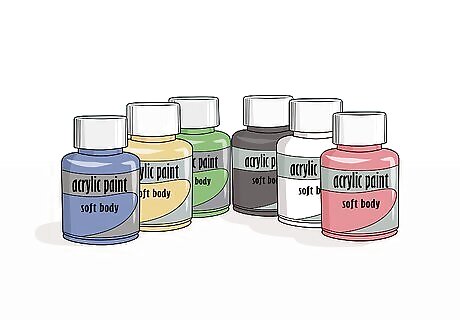
Get as many colors of soft-body acrylic paint as you want to use. This type of acrylic paint is best for pouring because it’s thin enough to flow across the canvas. It’s also called liquid or high-flow acrylic. Find this type of paint at arts and crafts stores. Get several different colors, as many as you want to use on your painting. There is no set number of colors to use for a pour painting. To get a good blend, use at least 4 different colors. Using more than 10 will be difficult unless you’re working on a very large canvas. Stick between 4 and 10 colors for now. Pick colors that complement each other. Blue, teal, silver, and purple would work together to create a tranquil setting. For a bolder look, try blending brighter colors like yellow, red, and orange.
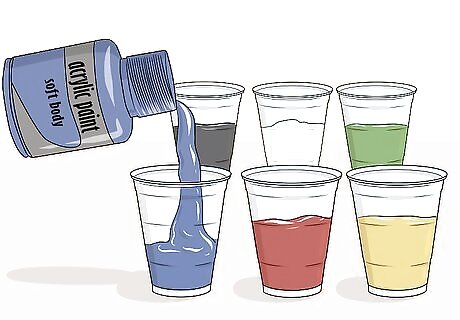
Pour each color you’re using into a separate plastic cup. Fill each cup 1/4 to 1/3 to the top, depending on the size of the painting and how much paint you have. Use a different cup for each color so the paint doesn’t mix together yet. Clear plastic cups are best so you can see the pouring level. If you don't have clear cups, then any other disposable plastic cup will also work.
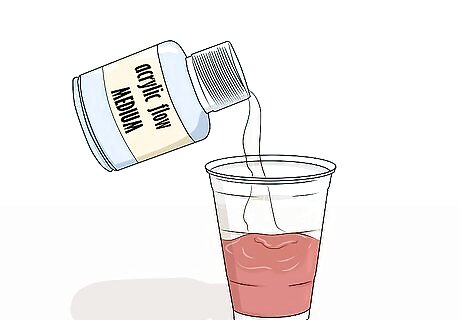
Mix each color with an equal amount of flow medium. Medium helps the paint bond to the canvas and resist damage over time. For pouring, flow medium is the best type because it keeps the paint thin enough to spread over the canvas. Get a bottle of flow medium designed for acrylic paint from a craft store. Then pour an amount equal to the amount of paint in each cup, so the mixture of paint to medium is 1:1. Stir each cup with a separate craft stick until the mixture is even. Other medium types are gel, modeling, and gloss. These won't work well for pouring because they thicken the paint. If you aren’t sure which type of medium to use, tell a craft store employee that you’re planning on doing a pour painting. They can point you towards the right product for this purpose. You can also use white glue mixed with an equal amount of water as a medium. Remember that this mixture won’t last as long as specialized paint medium.
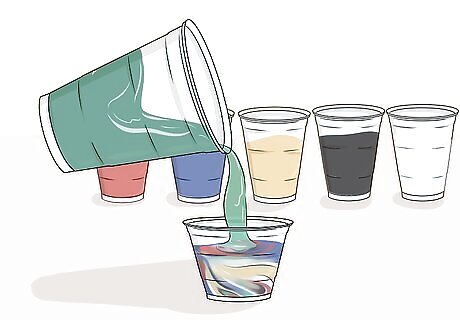
Pour all the colors into a cup in small amounts. Take an empty cup and place it on a flat surface. Then, pour each color into the cup a little at a time. Take the first color and just cover the bottom of the cup. Work in a pattern with the other colors. Pour in equal amounts like this until the cup is about 1/3 full. There are other methods for mixing the paint. Some artists prefer pouring in all or most of each color at once to get larger, solid streaks. Experiment and see which method you prefer. Do not stir or mix the paint together. It’ supposed to stay separate so the pouring creates the desired effect. If you’re working on a large canvas, then you may need more paint. Try filling the cup 1/2 full instead.
Using the Cup Method
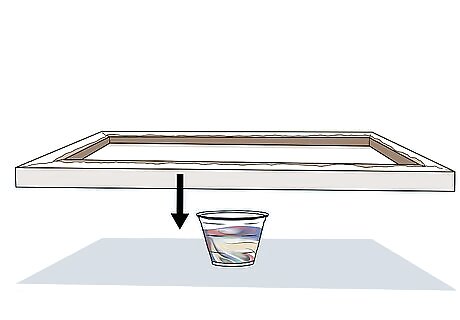
Place the canvas upside down on top of the cup. Make sure the canvas is centered so you don’t knock the cup over. Make a good seal between the canvas and cup so the paint doesn’t leak when you flip them. Don’t press down on the cup. You could break it and spill paint everywhere.
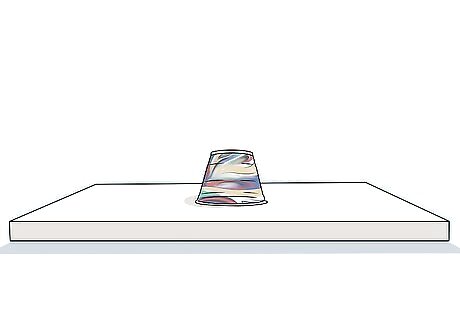
Flip the cup and canvas upside down without separating them. Grab the cup with one hand and hold your other hand flat against the canvas. Gently press them together. Then, flip them both together. Make sure the canvas and cup continue touching. Place the canvas down on the surface with the cup upside down. A little paint might leak out while you’re flipping the cup. That’s okay, it will get picked up when the paint spreads.
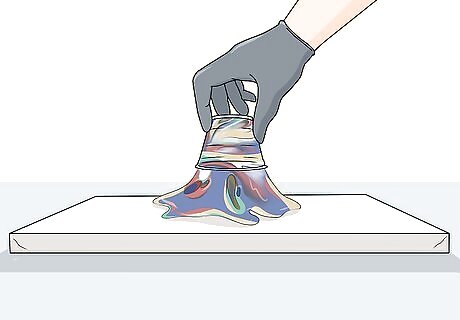
Lift the cup slowly and let the paint flow out. Leave the cup upside-down for a minute so the paint flows to the canvas. Then lift the cup up so it all spreads onto the canvas. The paint may come out quickly. That’s okay as long as you covered the surface you’re working on. Another technique for pour painting is slowly pouring the paint directly from the cup onto the canvas, without flipping them first. Try this method out as well, and stick with the one that gives you the best results.
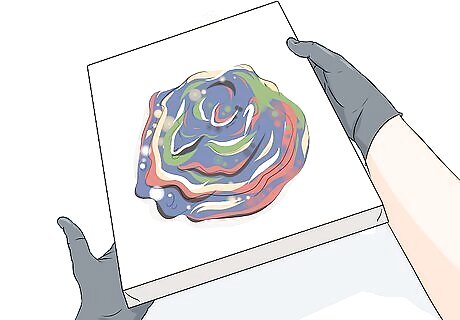
Pick up the canvas and move it around to spread the paint. Once the paint is on the canvas, it will flow freely. Pick the canvas up (this is why you’re wearing rubber gloves!) and tilt it around in different directions to spread the paint. Continue doing so until the paint covers the whole surface of the canvas. You’ll be left with an intricate design of streaks and different colors. Paint will probably drip off the sides of the canvas. That’s normal, and nothing to worry about as long as you covered the surface.
Hand-Pouring the Paint
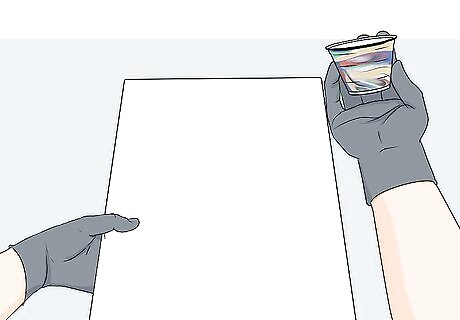
Start at the top of the canvas. For the hand-pouring technique, it's best to start at one side of the canvas and work across it. Choose the top portion, about 2 inches (5.1 cm) from the edge, to pour on for the best results. For different techniques, you could start in the center of the canvas or another location. When you're a beginner, working from one end to the other is easier.
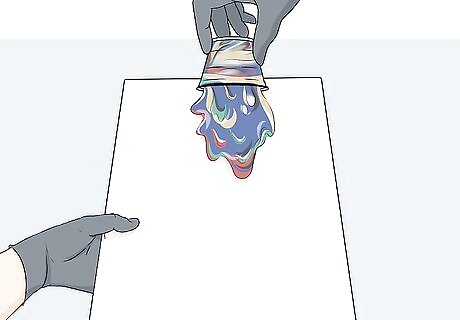
Tilt the cup over slowly until paint pours out. Hold the cup 6 inches (15 cm) from the canvas and tilt it slowly. Hold it over the spot when paint starts pouring out. Continue tilting the cup slowly to keep paint pouring at an even flow. Remember to pour slowly. Don't dump all the paint out in one spot. For a swirling effect, make very small circles with your hand as you pour the paint. This is optional for added effect.

Move the cup to the other side of the canvas slowly. Once the paint starts pooling in your original pouring location, then start moving the cup. Keep the cup tilted to maintain a steady paint flow and slowly move your hand to the other side of the canvas. If you want more paint on the canvas, just tilt your hand a little more to increase the flow. Don't worry if you run out of paint before you get to the other side. You can spread the paint around more when you pick the painting up. For other design options, try moving the cup back and forth as you pour. Experiment with different pouring directions to see which effect you like most.

Pick up the canvas and move it around the spread the paint. Once the cup is empty, then put it down and pick up the canvas. Tilt the painting in different directions to spread the paint around. Pick whichever direction you like. Continue tilting the painting until it covers the entire canvas surface. Keep the painting over the covered surface because paint will definitely drip off the sides. If you want to make different designs, you can continue tilting the painting after the entire surface is covered. The paint will continue flowing until it dries.
Finishing Your Painting
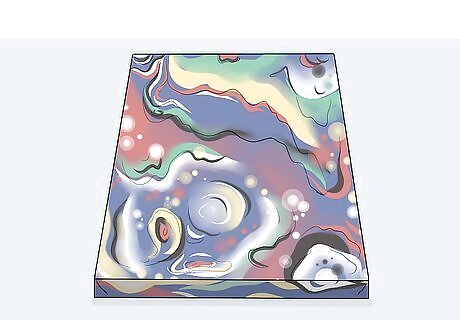
Store the painting so it's completely level. While the paint is still wet, it'll continue flowing, so your painting will be ruined if you leave it on a non-flat surface. Find a surface that you know is that. Put down cardboard or plastic to protect the surface, then lay the painting down face-up. To ensure a surface is flat, check it with a level before putting the painting down. Make sure nothing will touch or fall on the painting while it dries.

Let the painting dry for 2-3 days. Leave the painting undisturbed while it dries, or you could ruin your hard work. Keep children and pets away from the painting, and check back in 3 days to see if it's dry yet. If you're at all unsure whether the painting is dry yet, don't touch the front. This could leave a fingerprint and ruin the painting. Touch the side instead. If the painting is taking longer than normal to dry, the weather may be too humid. Try using a dehumidifier or turning up the air conditioner.
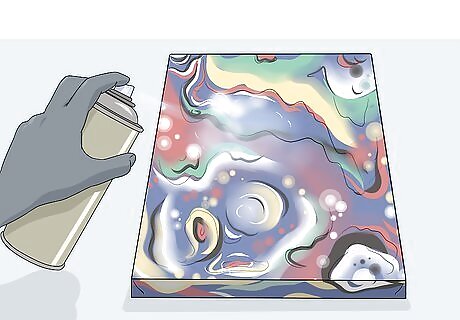
Seal the canvas to protect the paint. Once the paint is dry, a layer of varnish will seal and protect the painting. Get a can of spray-on varnish from a craft store. Shake the can and hold it 6 inches (15 cm) from the canvas, then spray a coat onto the painting. Keep the can moving so the varnish doesn't pool in one spot. Let the varnish dry for another 24 hours, then hang the painting wherever you'd like. There are other types of varnish as well, particularly brush-on types. For a pour painting, a brush-on varnish could smudge the paint, so stick with a spray type. Work in a ventilated area with an open window to prevent inhaling fumes.

















Comments
0 comment